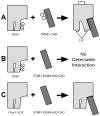A basic sequence in STIM1 promotes Ca2+ influx by interacting with the C-terminal acidic coiled coil of Orai1
- PMID: 20073506
- PMCID: PMC3236085
- DOI: 10.1021/bi901936q
A basic sequence in STIM1 promotes Ca2+ influx by interacting with the C-terminal acidic coiled coil of Orai1
Abstract
Store-operated Ca(2+) entry (SOCE) is a ubiquitous signaling process in eukaryotic cells in which the endoplasmic reticulum (ER)-localized Ca(2+) sensor, STIM1, activates the plasma membrane-localized Ca(2+) release-activated Ca(2+) (CRAC) channel, Orai1, in response to emptying of ER Ca(2+) stores. In efforts to understand this activation mechanism, we recently identified an acidic coiled-coil region in the C-terminus of Orai1 that contributes to physical association between these two proteins, as measured by fluorescence resonance energy transfer, and is necessary for Ca(2+) influx, as measured by an intracellular Ca(2+) indicator. Here, we present evidence that a positively charged sequence of STIM1 in its CRAC channel activating domain, human residues 384-386, is necessary for activation of SOCE, most likely because this sequence interacts directly with the acidic coiled coil of Orai1 to gate Ca(2+) influx. We find that mutation to remove positive charges in these residues in STIM1 prevents its stimulated association with wild-type Orai1. However, association does occur between this mutant STIM1 and Orai1 that is mutated to remove negative charges in its C-terminal coiled coil, indicating that other structural features are sufficient for this interaction. Despite this physical association, we find that thapsigargin fails to activate SOCE following coexpression of mutant STIM1 with either wild type or mutant Orai1, implicating STIM1 residues 384-386 in transmission of the Ca(2+) gating signal to Orai1 following store depletion.
Figures



 ), STIM1 K(384-6)Q-mRFP and wtOrai1 (
), STIM1 K(384-6)Q-mRFP and wtOrai1 ( ), wtSTIM1-mRFP and Orai1ΔDE (
), wtSTIM1-mRFP and Orai1ΔDE ( ), STIM1 K(384-6)Q-mRFP and Orai1ΔDE (
), STIM1 K(384-6)Q-mRFP and Orai1ΔDE ( ), and untransfected cells (
), and untransfected cells ( ). Fluo-4 fluorescence was normalized relative to the average prestimulation basal Ca2+ level in untransfected cells in the same field. Each time course represents the average of 10-18 cells, and error bars show SEM. Cells with basal Ca2+ levels >3x larger than the average for untransfected cells were excluded. B) Mean Ca2+ levels before and 10 min after addition of 150 nM thapsigargin for averaged individual COS7 cells expressing a combination of wtSTIM1-mRFP or mutant STIM1 K(384-6)Q-mRFP with wtOrai1 or mutant Orai1ΔDE. Each bar represents the mean for 20-60 cells from 3 or more different experiments, and error bars show SEM.
). Fluo-4 fluorescence was normalized relative to the average prestimulation basal Ca2+ level in untransfected cells in the same field. Each time course represents the average of 10-18 cells, and error bars show SEM. Cells with basal Ca2+ levels >3x larger than the average for untransfected cells were excluded. B) Mean Ca2+ levels before and 10 min after addition of 150 nM thapsigargin for averaged individual COS7 cells expressing a combination of wtSTIM1-mRFP or mutant STIM1 K(384-6)Q-mRFP with wtOrai1 or mutant Orai1ΔDE. Each bar represents the mean for 20-60 cells from 3 or more different experiments, and error bars show SEM.
References
-
- Feske S, Gwack Y, Prakriya M, Srikanth S, Puppel SH, Tanasa B, Hogan PG, Lewis RS, Daly M, Rao A. A mutation in Orai1 causes immune deficiency by abrogating CRAC channel function. Nature. 2006;441:179–185. - PubMed
Publication types
MeSH terms
Substances
Grants and funding
LinkOut - more resources
Full Text Sources
Miscellaneous

